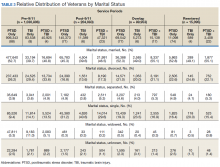Demographic Profile and Service-Connection Trends of Posttraumatic Stress Disorder and Traumatic Brain Injury in US Veterans Pre- and Post-9/11
Introduction: This study seeks to understand the demographic changes in the active-duty service member profile, both prior to and following September 11, 2001 (9/11). The study analyzed diagnosis of posttraumatic stress disorder (PTSD) and traumatic brain injury (TBI) and measures of severity of those diagnoses as recorded in service-connection ratings (percent disability).
Methods: A retrospective cohort-study of military veterans who received care at Veterans Health Administration medical centers between December 1998 and May 2014 was conducted based on clinical data recorded and stored within the Corporate Data Warehouse.
Results: A cohort of 1,339,937 veterans received an inpatient or outpatient diagnosis of PTSD and/or TBI. The cohort was divided into 4 service period groups and 3 diagnosis categories. The service periods included pre-9/11 (n = 1,030,806; 77%), post-9/11 (n = 204,083; 15%), overlap-9/11 (n = 89,953; 7%), and reentered post-9/11 (n = 15,095; 1%). The diagnosis categories included PTSD alone (n = 1,132,356; 85%), TBI alone (n = 100,789; 7%) and PTSD+TBI (n = 106,792; 8%). Results of the post-9/11 group revealed significant changes, including (1) increase of veterans with PTSD + TBI; (2) increase of female veterans with PTSD + TBI; and (3) increase of severity level of diagnosed PTSD/TBI as evidenced by higher service-connected disability pensions at younger age in the post-9/11 group. Additionally, data revealed unequal distribution of veterans with PTSD + TBI across geographic areas.
Conclusions: The veteran of the post-9/11 service period does not mirror the veteran of the pre-9/11 service period. Findings are valuable for policy making, allocation of resources, and for reconsidering the prevailing paradigm for treating veterans with PTSD and/or TBI.
Distribution by Race and Marital Status
The cohort identified as 65.7% white and 18.2% African American with much smaller percentages of Asians, American Indian/Alaska Natives (AI/AN) and Native Hawaiian/Pacific Islanders (Table 2). The relative proportion of AI/AN and Native Hawaiian/Pacific Islanders remained constant across all groups, whereas the number of Asians diagnosed with PTSD, TBI, or PTSD+TBI increased in the post-9/11 group. The number of African Americans diagnosed with PTSD, TBI, or both markedly increased in the overlap and reentered groups when compared with the pre-9/11 group, yet it went down in the post-9/11/group.
Half the cohort identified themselves as married (n = 675,145) (Table 3). A slightly larger proportion of those diagnosed with PTSD alone were married (51.7%), compared with those diagnosed with TBI only (40.3%), or PTSD+TBI (45.8%). Veterans in the post-9/11 group were less likely to identify as married (45.2%) compared with the pre-9/11 (51.2%), overlap (52.6%), or reentered (53.2%) groups. Divorce rates among pre-9/11 group, overlap group, and reentered group were higher compared with that of the post-9/11 group in all diagnosis categories.
Geographic Distribution
Veterans diagnosed with PTSD, TBI, or both were not evenly distributed across the VISNs VISNs 7, 8, 10, and 22 treated the most veterans, whereas VISN 9 and 15 treated the fewest. Taken together, the top 3 VISNs accounted for 27% to 28% of the total while lowest 3 accounted for 8% to 9% of the total cohort.
Service-Connected Disability
Of 1,339,937 veterans in the cohort, 1,067,691 had a service-connected disability rating for PTSD and/or TBI. Most were diagnosed with PTSD (n = 923,523, 86.5%) followed by both PTSD+TBI (n = 94,051, 8.8%). Three-quarters of the veterans with a service-connected disability were in the pre-9/11 group. Nearly 80% of veterans with a service-connected disability rating had a rating of > 50%. The average (SD) age of veterans with PTSD+TBI and a > 50% service-connected disability was 66.3 (11.2) years in the pre-9/11 group compared with 36.1 (8.7) years in the post-9/11 group.
Discussion
The demographic profile of veterans diagnosed with PTSD+TBI has changed across the service periods covered in this study. Compared with pre-9/11 veterans, the post-9/11 cohort: (1) higher percentage were diagnosed with PTSD+TBI; (2) higher proportion were nonmale veterans; (3) included more young veterans with > 50% service-connected disability; (4) were more racially diverse; and (5) were less likely to be married and divorced and more likely to be self-identified as single. Additionally, data revealed that veterans tended to locate more to some geographic regions than to others.
The nature of the warfare has changed remarkably over the past few decades. Gunshot wounds accounted for 65% of all injuries in World War I, 35% during Vietnam War, and 16% to 23% in the First Gulf War.24 In post-9/11 military conflicts, 81% of injuries were explosion related.24,25 Although improvements in personal protective gear and battlefield trauma care led to increased survival, several factors may have contributed to increased reporting of TBI, which peaked in 2011 at 32,000 cases.24-26








